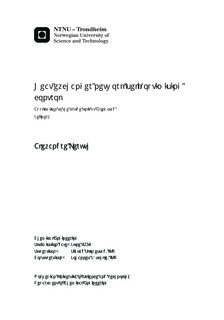| dc.contributor.advisor | Skogestad, Sigurd | nb_NO |
| dc.contributor.advisor | Jäschke, Johannes | nb_NO |
| dc.contributor.author | Leruth, Alexandre | nb_NO |
| dc.date.accessioned | 2014-12-19T13:23:51Z | |
| dc.date.available | 2014-12-19T13:23:51Z | |
| dc.date.created | 2013-06-16 | nb_NO |
| dc.date.issued | 2012 | nb_NO |
| dc.identifier | 629232 | nb_NO |
| dc.identifier | ntnudaim:8222 | nb_NO |
| dc.identifier.uri | http://hdl.handle.net/11250/248387 | |
| dc.description.abstract | This work applies the concept of self-optimising control for the operation of the given network. The steady-state performances of the self-optimising variables derived by Jäschke (Jäschke, 2012) are assessed and two main control configurations are examined: a simple decentralised control configuration (PIDs Control) and an advanced multivariable control configuration (Model Predictive Control). The steady-state performances appears to be moderate but need to be re-assessed using a proper steady-state model. The decentralised control configuration is found to present acceptable dynamic performances while the advanced multivariable configuration only enhances them a bit. | nb_NO |
| dc.language | eng | nb_NO |
| dc.publisher | Institutt for kjemisk prosessteknologi | nb_NO |
| dc.title | Heat exchanger network self-optimising control: Application to the crude unit at Mongstad refinery | nb_NO |
| dc.type | Master thesis | nb_NO |
| dc.source.pagenumber | 105 | nb_NO |
| dc.contributor.department | Norges teknisk-naturvitenskapelige universitet, Fakultet for naturvitenskap og teknologi, Institutt for kjemisk prosessteknologi | nb_NO |

